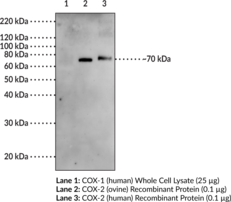Description
Immunoglobulin G (IgG) is a member of the immunoglobulin superfamily of glycoproteins that plays a central role in the adaptive immune response.{28520} It is produced by B cells and later secreted by plasma cells and is the most abundant circulating antibody in human and mouse serum.{28520,55170,55174} IgG consists of two heavy chains of approximately 50 kDa each and two light chains of approximately 25 kDa each.{28520} The heavy chains are linked together by disulfide bonds to form an Fc region and also combine with the light chains to form the Fab region, which mediate receptor and antigen binding, respectively.{55171} IgG is produced following IgM class-switching in response to infection and is involved in numerous humoral host defense responses, including antibody-dependent cell-mediated cytotoxicity (ADCC), toxin neutralization, and pathogen opsonization.{55170} IgG exists as four isotypes in mice: IgG1, IgG2b, IgG3, and, in a strain-specific manner, IgG2a or IgG2c.{55172,53858} In vivo, class switching to the IgG2a isotype can happen via IFN-γ-dependent and -independent mechanisms, with the former resulting from the cognate interaction of B cells with T helper 1 (Th1) cells.{52651} IgG2a is the predominant isotype produced in response to infection with DNA or RNA viruses in mice.{52652} Mammalian immunoglobulins contain either Igκ or Igλ light chains, each of which are composed of a constant and variable domain.{28687} Cayman’s IgG2aκ (mouse) Rabbit Monoclonal Antibody (Clone RM107) can be used for ELISA and Western blot (WB; non-reducing conditions) applications. The antibody recognizes the Fab region of IgG2aκ from mouse samples.
Synonyms: Immunoglobulin G2aκ
Immunogen: Mouse IgG
Formulation: 100 µg of protein A-purified monoclonal antibody
Isotype: Rabbit IgG
Applications: ELISA, WB (non-reducing conditions)
Origin:
Stability: 365 days
Application|ELISA||Application|Western Blot||Product Type|Antibodies|Monoclonal Antibodies||Research Area|Cardiovascular System|Blood|Serum Proteins||Research Area|Immunology & Inflammation|Adaptive Immunity||Research Area|Infectious Disease



